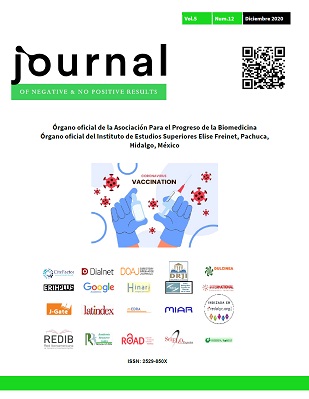Asymptomatic carriers of resistant methicillin Staphylococcus aureus (MRSA) in fishermen and horticulturists in Guerrero, Mexico
DOI:
https://doi.org/10.19230/jonnpr.3755Keywords:
MRSA, fishermen, horticulturists, bearer statusAbstract
Methicillin-resistant Staphylococcus aureus (MRSA) has been classically considered an opportunistic pathogen, causing various infections in humans and animals, it is resistant to multiple specific antibiotics that inder its control and treatment, it is found in the nasal passages of healthy people and it has been called a carrier state that produces reasons for alarm, since its appearance in the 1970s, which has spread in such a way that today it is the most important pathogen in the world considered a public health problem.
Metodology. Asymptomatic carriers were detected in fishermen and horticulturists in the state of Guerrero. 107 nasal samples were taken, S. aureus strains were cultivated and identified with specific biochemical tests, MRSA strains were evaluated by the disk diffusion method, by the Kirby-Bauer technique, following the international standards of CLSI.
Results. Were detected by resistance to oxacillin and being cefoxitin positive, of the results detected from 57 fishermen and 50 horticulturists, only four MRSA They were detected due to resistance to oxacillin and being cefoxitin positive. From the results obtained from 57 fishermen and 50 horticulturists, only four MRSA strains were detected in fishermen; detection of these strains in the environment could be important.
Conclusion. The presence of S. aureus is of epidemiological significance since it can be transmitted from people to people, food handlers that carry, since S. aureus, producers of enterotoxins, cause food poisoning, which is why this is the first report on carrier status of MRSA in fishermen and horticulturists in the state of Guerrero. Therefore, it is necessary to pay attention, since otherwise the results in public health could be negative.
Downloads
References
Bresolin, B. M. Z., Dall'Stella, J. K., y Fontoura-Da-Silva, S. E. (2005). Pesquisa sobre a bacteria Staphylococcus aureus en las mucosas nasales de manipuladores de alimentos en Curitiba/Paraná/Brasil. Estudios de biología 27(59).
Cervantes García, E., García González, R., y Schettino, P. M. S. (2015). Communityacquired Staphylococcus aureus. Revista Latinoamericana de Patología Clínica y Medicina de Laboratorio, 62(2), 100-111.
Cercenado, E., y de Gopegui, E. R. (2008). Community-acquired methicillin-resistant Staphylococcus aureus. Enfermedades infecciosas y microbiología clínica, 26, 19-24.
Clinical and Laboratory Standards Institute (CLSI) (2018). Reference method for broth dilution antifungal susceptibility testing of yeasts. Approved Standards M27-A2. Wayne, Pa.: National Committe for Clinical Laboratory Standards.
Figueroa G, Guillermo, Navarrete W, Paola, Caro C, Maricela, Troncoso H, Miriam, y Faúndez Z, Gustavo (2002). Portación de Staphylococcus aureus enterotoxigénicos en manipuladores de alimentos. Revista médica de Chile; 130(8), 859-864.
Jordá, G. B., Marucci, R. S., Guida, A. M., Pires, P. S., y Manfredi, E. A. (2012). Carriage and characterization of Staphylococcus aureus in food handlers. Revista Argentina de Microbiología, 44(2), 101-104.
National Committee for Clinical Laboratory Standards (NCCLS) 2005.
Togneri, A. M., Podestá, L. B., Pérez, M. P., y Santiso, G. M. (2017). Study of Staphylococcus aureus infections in a general acute care hospital (2002-2013). Revista Argentina de Microbiología, 49(1), 24-31.
World Health Organization. (2017). WHO publishes list of bacteria for which new antibiotics are urgently needed? https://www.who.int/es/news-room/detail/27-02-2017-who-publishes-list-of-bacteria-for-which-new- antibiotics-are-urgently-needed.
Published
Issue
Section
License
All accepted originals remain the property of JONNPR. In the event of publication, the authors exclusively transfer their rights of reproduction, distribution, translation and public communication (by any sound, audiovisual or electronic medium or format) of their work. To do so, the authors shall sign a letter transferring these rights when sending the paper via the online manuscript management system.
The articles published in the journal are freely used under the terms of the Creative Commons BY NC SA license, therefore.
You are free to:
Share — copy and redistribute the material in any medium or format
Adapt — remix, transform, and build upon the material
The licensor cannot revoke these freedoms as long as you follow the license terms.
Under the following terms:
Attribution — You must give appropriate credit, provide a link to the license, and indicate if changes were made. You may do so in any reasonable manner, but not in any way that suggests the licensor endorses you or your use.
NonCommercial — You may not use the material for commercial purposes.
ShareAlike — If you remix, transform, or build upon the material, you must distribute your contributions under the same license as the original.
No additional restrictions — You may not apply legal terms or technological measures that legally restrict others from doing anything the license permits.

This work is licensed under a Creative Commons Attribution-NonCommercial-ShareAlike 4.0 International License

























